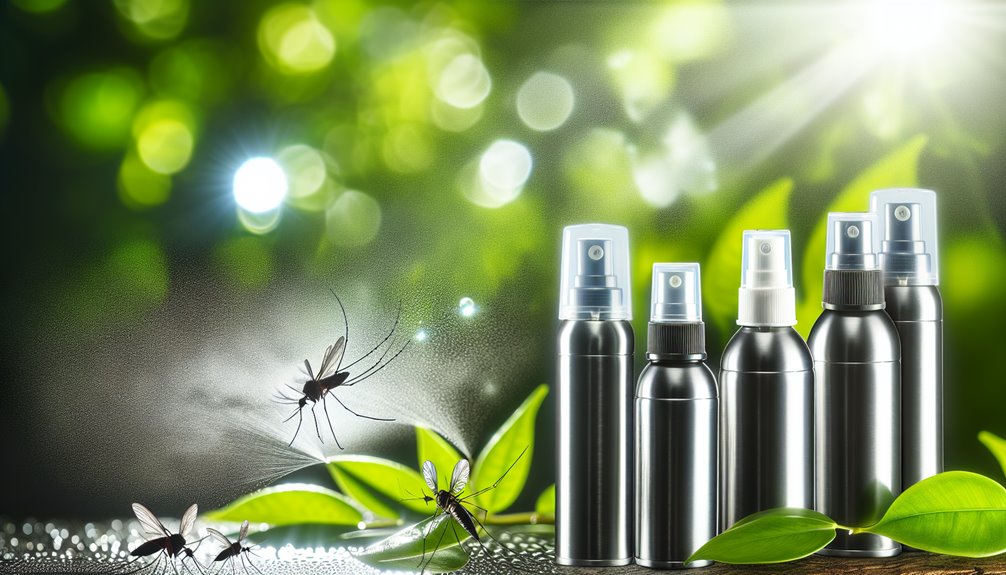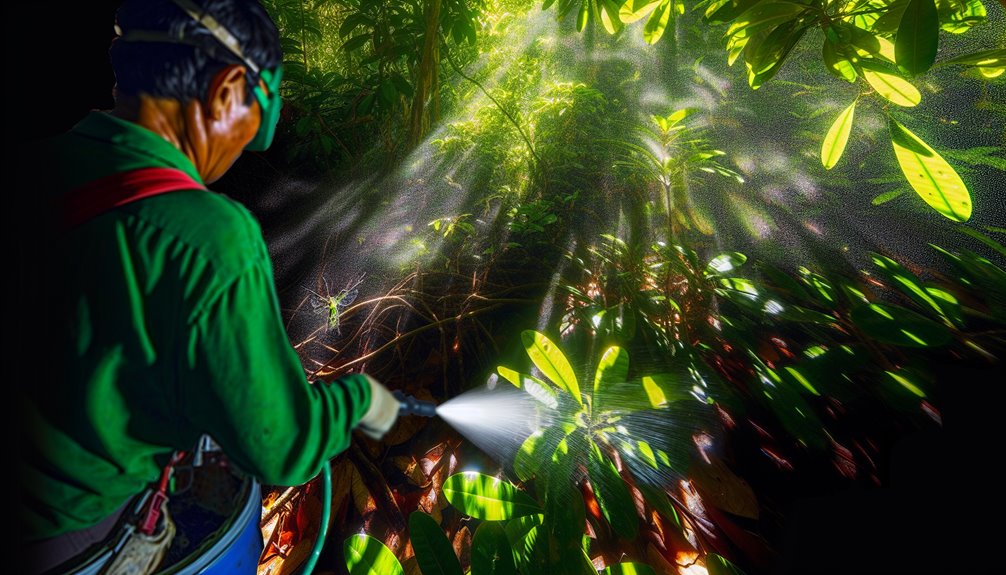You’re battling a tiny insect with a massive lifecycle—and your success hinges on timing, targets, and technique. You assess breeding sites, map shaded resting zones, and match products to stages: larvicides for water, residual adulticides for foliage. You factor temperature, photoperiod, and species behavior, then calibrate equipment for uniform coverage. You protect pollinators, people, and pets while tracking efficacy with inspections and counts. Done right, barriers aren’t just sprayed—they’re engineered. Now, what’s often missed?
Understanding Mosquito Biology and Life Cycles

Why do mosquitoes seem to appear overnight? You’re seeing synchronized surges driven by temperature, humidity, and their rapid life cycle. Eggs hatch into aquatic larvae, pupate, then emerge as adults in as little as 7–10 days under ideal conditions. Understanding mosquito anatomy clarifies control points: antennae detect CO2 and lactic acid; mouthparts differ—females pierce skin, males don’t; wings and tarsal organs guide flight and landing; spiracles regulate respiration. Females require vertebrate blood for egg development, then oviposit on water or damp substrates. You mitigate risk by timing interventions to developmental windows and aligning products with physiological targets.
Site Inspection and Breeding Source Identification
Before you deploy treatments, conduct a systematic site inspection to pinpoint breeding and resting habitats that sustain local mosquito populations. Start with a structured site assessment: map standing water, shaded vegetation, drains, gutters, irrigation leaks, and container accumulations. Measure water depth, turbidity, and turnover; note sun exposure and organic load. Record larval presence using dippers, turkey basters, or pipettes, and identify instars. Track adult resting sites with aspirators and visual counts at dawn/dusk. Document species indicators—egg rafts, floaters, and wrigglers—to infer breeding habits and flight ranges. Prioritize elimination of water sources, correct grading issues, and implement sanitation to sustain community protection.
Choosing Targeted Products and Active Ingredients

Although site data guide your strategy, product selection hinges on matching lifecycle stage, habitat type, and resistance profile to proven actives and formulations. You’ll pair larvicides (Bti, methoprene) with aquatic habitats and reserve adulticides (pyrethroids, clothianidin) for shaded resting sites. Validate susceptibility via local resistance reports; rotate active ingredients to preserve efficacy. Choose microencapsulated or residual formulations for foliage, and oil-based larvicides for polluted water. Apply synergists only when resistance data support them. Optimize selective exposure: treat target vegetation and cryptic harborage while protecting pollinator zones and water bodies. Calibrate droplet size, carrier volume, and label rates to guarantee consistent control.
Timing Treatments for Maximum Impact
Time treatment windows to coincide with mosquito biology and site conditions that maximize exposure and minimize drift. You’ll gain impact by targeting crepuscular activity peaks, low wind (<5 mph), and stable humidity after dawn or before dusk. Use regional phenology to schedule initial sprays just before adult emergence, then set treatment frequency based on residual half-life, rainfall, irrigation, and canopy density. Incorporate seasonal adjustments: tighten intervals in warm, wet months; extend in cool, dry periods. Align routes after storm events and high tide cycles in coastal areas. Validate timing with landing rate counts and CDC light traps, then document outcomes for continuous improvement.
Application Techniques for Foliage and Shaded Zones

With timing dialed in, you’ll maximize control by placing product where adults actually rest—deep in foliage, shaded understory, and cool, humid microhabitats. Use a low-volume backpack mistblower with 80–120 micron droplets to penetrate leaf layers without runoff. Calibrate flow and pace to achieve uniform coverage on the abaxial leaf surface, where adults roost. Target foliage treatments along perimeters, hedges, and vine tangles, prioritizing shaded zones with dense canopy. Sweep methodically: bottom-up, outside-in, pausing at cluster nodes. Avoid blooms. Maintain label-driven reentry intervals and buffer water. Document wind, temperature, and canopy density to verify deposition and ascertain repeatable service outcomes.
Addressing Structural Harborage and High-Traffic Areas
Two zones demand disciplined attention: structural harborage and human congregation points. You’ll map structural design and traffic patterns to target where mosquitoes rest and intercept hosts. Focus on microclimates, shadow lines, and wind-sheltered recesses. Treat with calibrated residuals, using low-volume, even coverage to avoid drift and waste. Prioritize inspection, measurement, and documentation to sustain outcomes.
- Under eaves: cool soffit voids where adults stage at dawn.
- Crawlspace vents: screen edges and sill plates retaining moisture.
- Fence lines: shaded joints aligning with prevailing winds.
- Stairwells and breezeways: eddies created by corridor geometry.
- Queue zones: grills, playsets, and seating nodes that aggregate carbon dioxide.
Safety Protocols for People, Pets, and Pollinators
Although barriers can cut vector pressure fast, you’ve got to stage treatments within a defensible safety plan that protects residents, animals, and non-target insects. You verify labels, calculate dose by canopy density, and restrict drift with calibrated nozzles. Post-entry intervals matter—communicate reentry times, ventilate, and cordon treated zones. For pet safety, kennel animals indoors, cover bowls, and clean contact surfaces after drying. You schedule around bloom, avoid open flowers, and target shaded resting sites to maximize pollinator protection. Notify neighbors, document product lots, and pre-screen sensitive populations. Wear proper PPE, mix in containment, and maintain chain-of-custody for equipment decontamination.
Environmental Considerations and Product Stewardship
Safety at the point of application only works when you match it with environmental stewardship across the site and product life cycle. You select formulations with minimal non-target toxicity, apply at label rates, and use drift-reduction techniques to protect ecological balance. You also manage containers, rinsates, and records to uphold product stewardship and sustainable practices from purchase to disposal.
- Calibrated nozzles misting only targeted vegetation
- Buffer zones shielding water, gardens, and pollinator habitat
- Weather windows: low wind, dry foliage, no rain forecast
- Closed-loop mixing, triple-rinse, and compliant disposal
- Rotation and integration with habitat modification, larval source reduction
Maintenance Intervals and Monitoring for Lasting Control
When residues decline and breeding pressure shifts, you maintain control by scheduling inspections and barrier reapplications at defined intervals tied to product half-life, weathering, and site risk. You set monitoring frequency using adult landing counts, BG or CDC trap indices, and larval dip rates, then adjust treatment schedules accordingly. After storms, irrigations, or pruning, you reassess coverage loss and re-treat high-traffic vegetation. Track temperature, UV, and rainfall to anticipate degradation. Rotate actives to manage resistance and document findings with geo-tagged photos and lot numbers. Communicate thresholds, such as >2 landings/minute, so clients understand why you intervene before complaints rise.
Conclusion
As the owner of Mosquito Eliminators of South MS, I truly understand the importance of creating a safe and comfortable outdoor environment for you and your loved ones. Our approach to mosquito elimination is not just about treating the problem; it’s about crafting a personalized strategy that adapts to your specific needs. I invite you to explore more about our services at mosquitoeliminatorsms.com or give us a call at (601) 336-2277. Let’s work together to reclaim your outdoor spaces and ensure that you can enjoy every moment without the worry of pesky mosquitoes. We’re here to help you win the war against these unwelcome guests!

